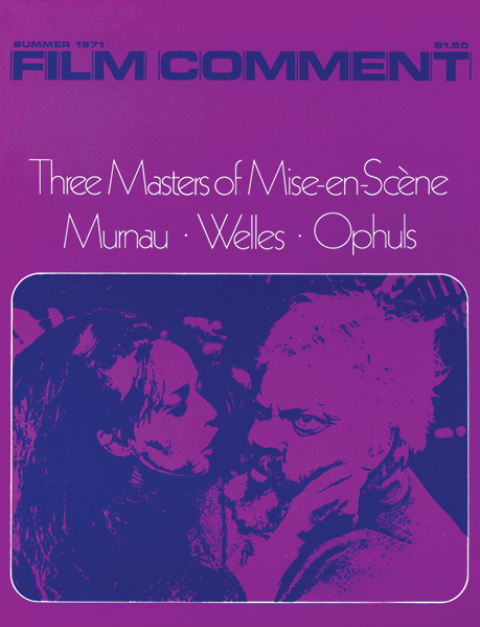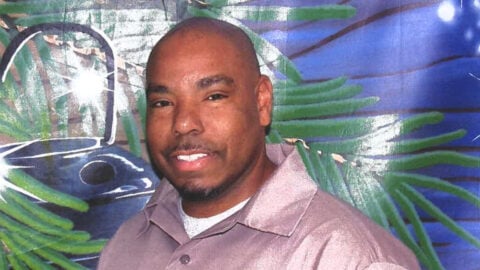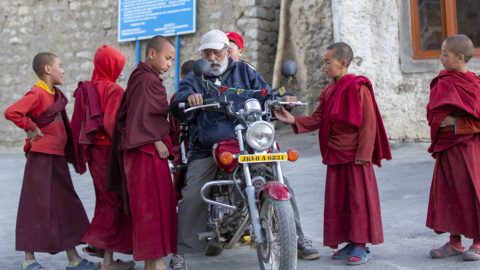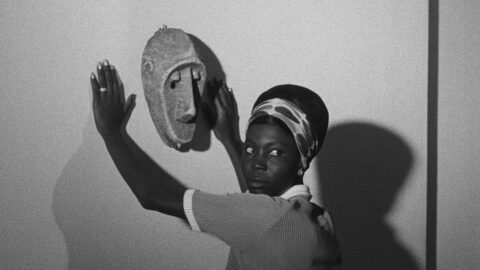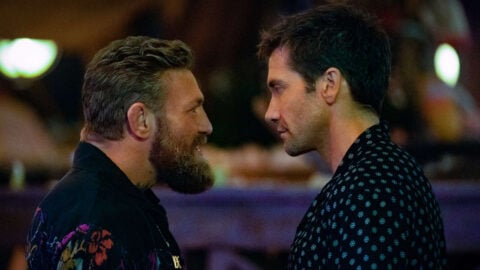
One of the crucial changes Welles makes in adapting Whit Masterson’s novel to his own uses is shifting the action from San Diego to the Mexican border.1 But Touch of Evil’s “Mexico” is not the place liberal critics think it is. Such critics should have been warned by Janet Leigh’s mistake: she pleads with her husband to “get me out of here” (this is not the “real Mexico,” Vargas tries to tell her), and thinks she’ll be safe in an American motel. Welles’ “Mexico” is not a scene for acting out platitudes about bigotry and social justice; it is a place of the soul, the “foreign” place, the nightmare from which a lost Hollywood sweater girl—Mrs. Tony Curtis, the antithesis of all Dietrich’s weary experience—begs to be awakened.
To put it differently: “Mexico” is not geographical but visual space, a way of experiencing the world. Welles’ habitually deep focus means that any place a character may, for an instant, inhabit is only the edge of the depth that opens dizzily behind him, receding along the arcades of Venice, California, like some baroque hallucination. The violence of the motion Welles sets plunging through these depths means that “foreground” and “background” no longer serve as static frames for a comfortable middle distance (a “middle” both optically and ethically). Instead, all three are points in a single system, through which, just beyond the circle closed about any given moment’s awareness, the assassin pursues his prey, and through whose sinuous passages the investigator must seek out an unknown evil. Menace lurches suddenly forward, and chases disappear down long perspectives; or we may be confronted with more interior searches: a single figure, dwarfed by the geometry of empty streets and arcades, wandering through a landscape of memory, littered with blown papers and the ruins of an abandoned carnival.
We may best understand the perceptual world of Touch of Evil by thinking of it as a labyrinth, in which the viewer too is invited to lose himself: the network of odd angles; the brutally discontinuous montage; the chiaroscuro and intermittent glare of neon; the pervasive, only half-heard, Latin drums and sudden blasts of fortyish jazz; the overlapping voices and, particularly in scenes in which the depth of field is most in evidence (e.g., Grandi pursuing his “boys” and losing his hairpiece), the dislocation of sound in space, as if the seen and the heard could no longer be held together in a single coherent world. At a time when this film is still praised for its “love of the film medium,” as if Welles were only an avatar of Norman Jewison, it is important to insist on the rigor with which all the cinematic means converge toward a single end: menace, disequilibrium. The middle shot, as André Bazin has written, appeals to the “natural point of balance of [the viewer’s] mental adjustment.”2 The intention of Welles’ style is precisely to subvert this balance; by opening upon the vertiginous ambiguities of space to deny us the safety of the frame of reference through which we habitually contemplate the world—the plan-Américain of our waking life. Consider, for example, Quinlan’s first appearance. No establishing shot allows us to orient ourselves before his massive intrusion: first, a low-angled shot of the car door opening, then, looming above it, a close-up of the great puffy face and huge cigar-not so much seen as felt, like the disquieting presences of nightmares.

At those points when the action becomes most convulsive (the murder of Grandi, for example, or the earlier acid-throwing episode), Welles sets camera and actors moving in opposite directions so that, deprived of any fixed point of reference, we are pulled into a vortex of irrational motion, of violent gestures no longer commensurable. The vertigo of such moments is the exact optical equivalent of the moral hysteria whose precipitate (as Welles has observed) is the idiotic motel keeper, hopping and giggling away over a windswept, featureless landscape: a vast emptiness marked by a single ghostly tree and by the shabby buildings where Vargas’ wife sought refuge in what she soon discovers to be the very bosom of her tormentors—“Who do you think this place belongs to anyway?”
Welles speaks of this night-man as a “Shakespearean fool,”3 but his own sensibility has always seemed less attuned to tragedy or comedy than to melodrama or farce, modes whose dreamlike and incommensurate gestures create their own space. The night-man’s scenes—or many of those with Akim Tamiroff’s superb Grandi—suggest that the special landscape of Touch of Evil is the unstable place where farce and melodrama converge; or, more exactly, the place where farce is born from the convulsions of melodrama: the “estranged world” of the grotesque. It is here, I think, that we find the most exact and comprehensive term for Welles’ dizzying theatrics. The grotesque: “a play with the absurd,” a sinister game that may “carry the player away, deprive him of his freedom” ever to return to the familiar daylight.4
“I believe, thinking about my films, that they are based not so much on pursuit as on a search,” Welles has said. “If we are looking for something a labyrinth is the most favorable location for the search.”5 An odd enough remark, if we care to press it closely. The labyrinth is the “most favorable” place for a search only to an investigator preoccupied with the tortuousness of his own seeking: only if what the searcher really wants is to lose himself, if his real goal is the hall of mirrors where at last he comes upon his own image shivered into a thousand fragments. (For one hallucinatory moment, as Kane passes between two mirrors, the camera hovers as if to plunge down the corridor of images, as if to lose itself-and us-in reflected depths more real than the hallway along which the hunched manikin Kane has become disappears off the side of the screen.) The reporter of Citizen Kane does not, to be sure, run any such risks; faceless himself, a fabricator of public images, he uncovers the labyrinth without entering into its mystery. But as Van Stratten learns in Mr. Arkadin, such labyrinths are places of pursuit as well as of search, places in which the search inexorably becomes a pursuit when the mystery closes down about the hapless inquisitor-as it does about Vargas, smashing with impotent fury through the narrow barroom where his enemies celebrate their inexplicable triumph, then, without transition, winding through the corridors of Quinlan’s jail to find his bride delirious in her cell. The peril that must be confronted is finally the nature of the search itself; the puzzle of the labyrinth and its menace are one: the bomb moving slowly through narrow streets.

Welles’ preoccupation with such images may suggest why the energies of his art are most fully liberated by the thriller, the roman noir: stories that violate the autonomy of space and time and reassemble their fragments in order to satisfy the investigator’s taste for conspiracy—or hallucination. Such an enterprise presupposes the breakdown of conventional categories of understanding—moral, social, even psychological; things are not what they seem, there is more than meets the eye. Deprived of their familiar aspect, things portend (like the debris Kane leaves behind him in Xanadu) a significance not yet made manifest: the blind woman presiding over Vargas’ telephoned declarations of love and assurance; the strangely elongated bed in an empty room of an empty motel in an empty landscape; Quinlan’s very face, like a mask or an icon. A world of clues (as the etymology of the word suggests) assumes a labyrinth. If Welles’ style seems rhetorical, it is because his characters, like medieval mystics, inhabit a universe whose least component is an exhortation, a summons—for one who knows how to listen—to hidden mystery. In Welles, however, the abyss to which one is called by all things is not the abyss of God, but Quinlan’s vision of inexplicable violence and universal guilt: “guilty, guilty, every last one of them guilty.”
I have so far been speaking rather melodramatically and obliquely, because this seems to me the appropriate way to deal with Welles, and in particular with the peculiarly parabolic manner in which Touch Of Evil communicates its intuitions. What the film is “about” is not distinct from what we might call the phenomenology of its cinematic style. It is, quite simply, about being lost in the labyrinth whose dimensions I have been trying to adumbrate. “What’s that got to do with me?” Janet Leigh asks the whispered menace through the walls of the Mirador Motel. But when she wakes, her conventionally pretty blonde face illuminated by blinking neon, it is to open her eyes on the inverted, farcically leering mask of the strangled Grandi, to plunge half naked into a cacophony of street sounds, jazz, and strident jeering, to watch from her fire escape while her husband, oblivious to her cries for help, passes slowly away through the maze of indifferent or threatening strangers.
As the film’s center of gravity shifts from the trials of Susan Vargas to the figure of Quinlan himself, we begin gradually to see not only the terror and perplexity of the labyrinth, but also its moral and psychological dimensions. There is a shift, in other words, from the lyric to the dramatic, from passion to action—from a mode of understanding that seeks to come to grips with the “foreign place” by submitting wholly to its darkness, to another mode whose aim is to humanize the void by placing it in the sequence of choice and striving that constitutes the history of a man’s life. To put the matter crudely: in Touch Of Evil we gradually see that the labyrinth in which innocence loses its way is simply time, Simply the life, a man lives-any man, “some kind of a man,” everyone being hooked on something, as Tanya says-and which he builds up around himself, fragment by fragment, until finally there is no escape. The gradual enrichment or specification of its central image constitutes the film’s visual structure; for the sake of exposition, we may distinguish three stages in Quinlan’s career. The first sequence enacts Quinlan’s absorption into the labyrinthine world of Uncle Joe Grandi (or we should say, “reenacts,” for obviously Quinlan is in fact no stranger to its deviousness). “We’re both after the same thing.” Quinlan and Grandi confer in the street, while Menzies looks on sadly through a window reflecting their figures, and a church bell rings in the distance. Later, in the cafe, Quinlan protests “that ‘we’ stuff,” hunched rigidly behind a table as Grandi cringes and scurries behind him; but as Quinlan capitulates and begins to drink, the camera rises to see the two men as a single unit.

Confronted with Vargas’ evidence, Quinlan offers to turn in his badge and is followed out into the hotel’s deserted lobby. Having been questioned, a career, a life, loses its solidity-the camera constantly circling and probing-and what is left is a dance of silhouettes through empty space: disembodied voices and shadows cast by the dim institutional lighting. And then, two scenes later, rhetoric and nostalgia are gone. Time freezes into a labyrinth of steel filing cabinets, a tangle of lies and falsification seen with the hard edge of public record, under a glare without mystery or reprieve. Even here, however, Menzies interposes matters that suggest the persistence of shadows, of a more human chiaroscuro, beyond the range of the Prosecutor’s vision; of the story of his murdered wife, and of his peculiar intimacy with Tanya (with whom, in his concern, Menzies has just been speaking).
In the final sequence, Quinlan’s life is recapitulated as a kind of night journey, a labyrinth threaded over stagnant waters. All the film’s stylistic preoccupations are here in their purest form. The space of nightmare, at once claustrophobic and fragmented, wholly shaped by the network of derricks and aborted construction, is slashed through by inexplicable lighting; voices echoing over the canal or metallically disembodied on Vargas’ tape recorder. And now it becomes clear that the dark tangle in which Quinlan is lost-which turns into a trap where his mind drifts and wanders without control—is nothing else than the long obsession of which he speaks to Menzies. “Drunk or sober, I always think of her,” he says. “Or of my job, my dirty job.” The “Mexico” of Touch Of Evil is, finally, Quinlan’s world: he embraces the film as the dreamer does his own nightmare. I have spoken of Dietrich and Janet Leigh as antitheses, but this is itself to imply some basic correspondence. What the pianola summons Quinlan to, across the vacant windy plaza, is simply the dream of all he has lost, the negation of the world he has built up around himself along with the layers of fat: the nostalgic melody in a world of raucous sounds, the embrace of the brothel’s tacky décor in a world of bare rooms and empty arcades. No wonder, then, that Tanya’s ageless face, wreathed in cigarette smoke, hovers in the doorway like a figure of memory, a dream within a dream, a myth. Not, however, the brittle falsehood represented by Janet Leigh or the abandoned pasteboard showgirl momentarily glimpsed in the plaza’s debris. Dietrich’s special magic has always been to suggest the human face behind cinema’s masks of glamour and romance, the dream saddened by a knowledge of its own evanescence. Her first words are “We’re closed.” What this face knows is that the work of time is as irrevocable as the work of candy bars; and when, just before the end, Quinlan asks Tanya to read his future in her cards, it appears that this too is deprived him: “You don’t have any, your future’s all used up.” Time has become a single moment, a labyrinth open only to the junk heap on which (like Kane) Quinlan finally dies, his rotting face still cunning, as used up and inscrutable as the debris around him. He was “some kind of a man,” Tanya says. Janet Leigh continues to suppose that Vargas can “take me away from here,” but Welles reserves the last words for Dietrich ’s stylized epitaph, and the last shot for her melancholy walk away into the night.
1. Vargas, a drug investigator for the Mexican government, and his bride Susan witness the explosion of a car as it passes over the border. The American sheriff, Quinlan, fastens upon the Mexican boyfriend of the wealthy victim’s daughter as his chief suspect; meanwhile Susan is being terrorized by “Uncle Joe” Grandi, whose brother Vargas had convicted on a drug charge. Vargas discovers that Quinlan has planted evidence in order to frame his suspect; alarmed by these accusations, Quinlan makes common cause with Grandi in order to discredit Vargas. Susan is held captive in an American motel owned by Grandi and (apparently) drugged, so that Quinlan can claim that both she and Vargas are addicts. But when Grandi, with the still unconscious Susan, meets Quinlan in a hotel on the Mexican side of the border, Quinlan strangles Grandi and leaves the corpse behind to be discovered, along with Vargas’ half-naked bride, by the police. Meanwhile Vargas discovers that Quinlan, obsessed by the unsolved murder of his wife, has made a career of falsifying evidence. When Quinlan’s best friend, Pete Menzies, discovers Quinlan’s cane at the murder scene, he reluctantly agrees to work with Vargas. Equipped with a “bug,” Menzies seeks Quinlan out at a brothel where he has taken refuge with Tanya, and engages him in a long conversation, which Vargas, tracking the two, gets down on his tape recorder. After he has confessed, Quinlan discovers the deception, shoots Menzies, and is about to kill Vargas too, when he is himself shot by the expiring Menzies. Vargas learns that the young Mexican Quinlan framed was in fact guilty and has confessed to dynamiting the car.
2. Andre Bazin, What Is Cinema?, trans. Hugh Gray (Berkeley, 1967), p. 32.
3. Jean-Claude Allais, “Orson Welles,” Premier Plan, 16 (March, 1961), p. 68.
4. See Wolfgang Kayser, The Grotesque in Art and Literature, trans. Ulrich Weisstein (Bloomington, Ind., 1963), pp. 184-89.
5. Andrew Sarris, ed., Interviews with Film Directors (New York, 1967), p. 532.



